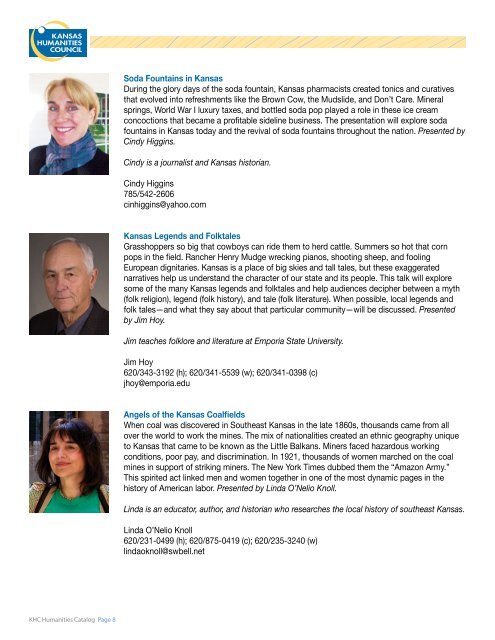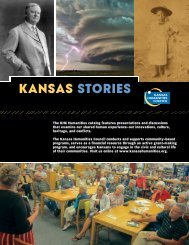KANSAS STORIES
1SvGw1V
1SvGw1V
Create successful ePaper yourself
Turn your PDF publications into a flip-book with our unique Google optimized e-Paper software.
Soda Fountains in Kansas<br />
During the glory days of the soda fountain, Kansas pharmacists created tonics and curatives<br />
that evolved into refreshments like the Brown Cow, the Mudslide, and Don’t Care. Mineral<br />
springs, World War I luxury taxes, and bottled soda pop played a role in these ice cream<br />
concoctions that became a profitable sideline business. The presentation will explore soda<br />
fountains in Kansas today and the revival of soda fountains throughout the nation. Presented by<br />
Cindy Higgins.<br />
Cindy is a journalist and Kansas historian.<br />
Cindy Higgins<br />
785/542-2606<br />
cinhiggins@yahoo.com<br />
Kansas Legends and Folktales<br />
Grasshoppers so big that cowboys can ride them to herd cattle. Summers so hot that corn<br />
pops in the field. Rancher Henry Mudge wrecking pianos, shooting sheep, and fooling<br />
European dignitaries. Kansas is a place of big skies and tall tales, but these exaggerated<br />
narratives help us understand the character of our state and its people. This talk will explore<br />
some of the many Kansas legends and folktales and help audiences decipher between a myth<br />
(folk religion), legend (folk history), and tale (folk literature). When possible, local legends and<br />
folk tales—and what they say about that particular community—will be discussed. Presented<br />
by Jim Hoy.<br />
Jim teaches folklore and literature at Emporia State University.<br />
Jim Hoy<br />
620/343-3192 (h); 620/341-5539 (w); 620/341-0398 (c)<br />
jhoy@emporia.edu<br />
Angels of the Kansas Coalfields<br />
When coal was discovered in Southeast Kansas in the late 1860s, thousands came from all<br />
over the world to work the mines. The mix of nationalities created an ethnic geography unique<br />
to Kansas that came to be known as the Little Balkans. Miners faced hazardous working<br />
conditions, poor pay, and discrimination. In 1921, thousands of women marched on the coal<br />
mines in support of striking miners. The New York Times dubbed them the “Amazon Army.”<br />
This spirited act linked men and women together in one of the most dynamic pages in the<br />
history of American labor. Presented by Linda O’Nelio Knoll.<br />
Linda is an educator, author, and historian who researches the local history of southeast Kansas.<br />
Linda O’Nelio Knoll<br />
620/231-0499 (h); 620/875-0419 (c); 620/235-3240 (w)<br />
lindaoknoll@swbell.net<br />
KHC Humanities Catalog Page 8



